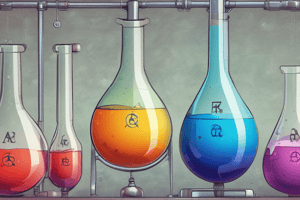Podcast
Questions and Answers
What is the characteristic of a strong acid?
What is the characteristic of a strong acid?
- Readily accepts protons
- Readily donates protons (correct)
- Forms salts easily
- Does not react with bases
According to the Bronsted-Lowry theory, how is a base defined?
According to the Bronsted-Lowry theory, how is a base defined?
- Water creator
- Salt producer
- Proton donor
- Proton acceptor (correct)
What happens when an acid reacts with a base?
What happens when an acid reacts with a base?
- H⁺ ions are consumed
- Oxygen gas is released
- A salt is formed (correct)
- An acid is created
Which of the following is a weak base?
Which of the following is a weak base?
What defines the conjugate base of an acid according to the Bronsted-Lowry theory?
What defines the conjugate base of an acid according to the Bronsted-Lowry theory?
What type of compound is formed by the reaction between an acid and a base?
What type of compound is formed by the reaction between an acid and a base?
What is the pH value of a neutral solution on the pH scale?
What is the pH value of a neutral solution on the pH scale?
Which of the following is a weak acid?
Which of the following is a weak acid?
What is the relationship between pH and pOH in a solution?
What is the relationship between pH and pOH in a solution?
Which of the following is a strong base?
Which of the following is a strong base?
What are the products formed when hydrochloric acid (HCl) neutralizes sodium hydroxide (NaOH)?
What are the products formed when hydrochloric acid (HCl) neutralizes sodium hydroxide (NaOH)?
In which industry are acids commonly used as preservatives?
In which industry are acids commonly used as preservatives?
Flashcards are hidden until you start studying
Study Notes
Acid, Base, and Salt
Acids
Acids are substances that donate protons (H⁺ ions) to other substances. According to the Bronsted-Lowry theory, an acid is a proton donor, and its conjugate base is the anion that results from the loss of a proton. Examples of acids include hydrochloric acid (HCl), sulfuric acid (H₂SO₄), nitric acid (HNO₃), and acetic acid (CH₃COOH).
Bases
Bases, on the other hand, are substances that accept protons (H⁺ ions) from other substances. According to the Bronsted-Lowry theory, a base is a proton acceptor, and its conjugate acid is the species that results from the donation of a proton. Examples of bases include sodium hydroxide (NaOH), calcium hydroxide (Ca(OH)₂), and ammonia (NH₃).
Salts
A salt is a compound formed by the reaction between an acid and a base. In this reaction, the acid donates a proton to the base, resulting in the formation of a new compound with a specific stoichiometry. For example, the reaction between hydrochloric acid (HCl) and sodium hydroxide (NaOH) produces sodium chloride (NaCl) and water (H₂O).
Strong and Weak Acids and Bases
Acids and bases can be classified into different categories based on their strength, which is determined by their ability to donate or accept protons. Strong acids and bases are those that readily donate or accept protons, while weak acids and bases are those that do so less readily. Examples of strong acids include hydrochloric acid (HCl) and sulfuric acid (H₂SO₄), while weak acids include acetic acid (CH₃COOH) and hydrofluoric acid (HF). Similarly, strong bases include sodium hydroxide (NaOH) and potassium hydroxide (KOH), while weak bases include ammonia (NH₃) and sodium carbonate (Na₂CO₃).
pH and pOH
The pH and pOH of a solution are measures of its acidity and basicity, respectively. The pH scale ranges from 0 to 14, with 7 being neutral, and the pOH scale ranges from -14 to 0. The relationship between pH and pOH is given by the equation pH + pOH = 14, where the pH of a solution is the negative logarithm of the concentration of hydrogen ions (H⁺) and the pOH is the negative logarithm of the concentration of hydroxide ions (OH⁻).
Neutralization Reactions
When an acid reacts with a base, the products formed are a salt and water. This process, known as neutralization, results in the formation of a salt and a change in the pH of the solution. For example, the reaction between hydrochloric acid (HCl) and sodium hydroxide (NaOH) produces sodium chloride (NaCl) and water (H₂O), as well as a change in pH.
Uses of Acids, Bases, and Salts
Acids, bases, and salts have a wide range of applications in various industries, including agriculture, medicine, and food production. Acids are used as preservatives, while bases are used in the production of cleaning agents. Salts are used in various industrial processes, such as the manufacture of fertilizers and the production of chemicals.
In summary, acids, bases, and salts are important substances in chemistry that play a crucial role in various chemical reactions and processes. Understanding the properties and behavior of these substances is essential for their proper use in various applications.
Studying That Suits You
Use AI to generate personalized quizzes and flashcards to suit your learning preferences.




